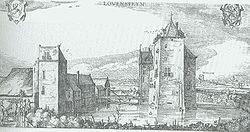Castle Loevestein
| Loevestein Castle | |
|---|---|
| Slot Loevestein | |
| Poederoijen, the Netherlands | |

Slot Loevestein
|
|

Slot Loevestein (1621)
|
|
| Coordinates | 51°48′59″N 5°01′17″E / 51.8164°N 5.0214°ECoordinates: 51°48′59″N 5°01′17″E / 51.8164°N 5.0214°E |
| Type | Castle |
| Site information | |
| Open to the public |
Yes |
| Condition | Good |
| Website | www |
| Site history | |
| Built | 1361 |
| Built by | Dirc Loef van Horne |
Loevestein Castle (Dutch: Slot Loevestein) is a medieval castle in the municipality of Zaltbommel, Gelderland, the Netherlands.
The castle was built by the knight Dirc Loef van Horne (hence "Loef's stein" (stone) house) between 1357 and 1397. Until World War II Loevestein Castle was part of the Hollandic Water Line, the main Dutch defense line that was based on flooding an area of land south and east of the western provinces. Currently the castle is used as a medieval museum and function centre.
Loevestein is a water castle that was built between 1357 and 1368. It was built in a strategic location in the middle of the Netherlands, where the Maas and Waal rivers come together (just west of current day villages of Poederoijen and Brakel, in the municipality of Zaltbommel, in Gelderland). At first it was a simple square brick building, used to charge toll from trading vessels using the rivers. By 1372, the castle was under control of the Counts of Holland. In the 16th century (around 1575, orders given by William the Silent) it was expanded to a larger fortress surrounded by earthen fortifications with two (later three) stone bastions on the northern side, two moats, an arsenal, and housing for a commander and soldiers. The Castle was also part of the Hollandic Water Line.
It changed hands twice between the Northern Dutch and the Spanish during the Eighty Years' War: on December 9, 1570, it was taken by the Geuzen; ten days later by the Spanish again; and on June 25, 1572, it was retaken by the Dutch.
...
Wikipedia

